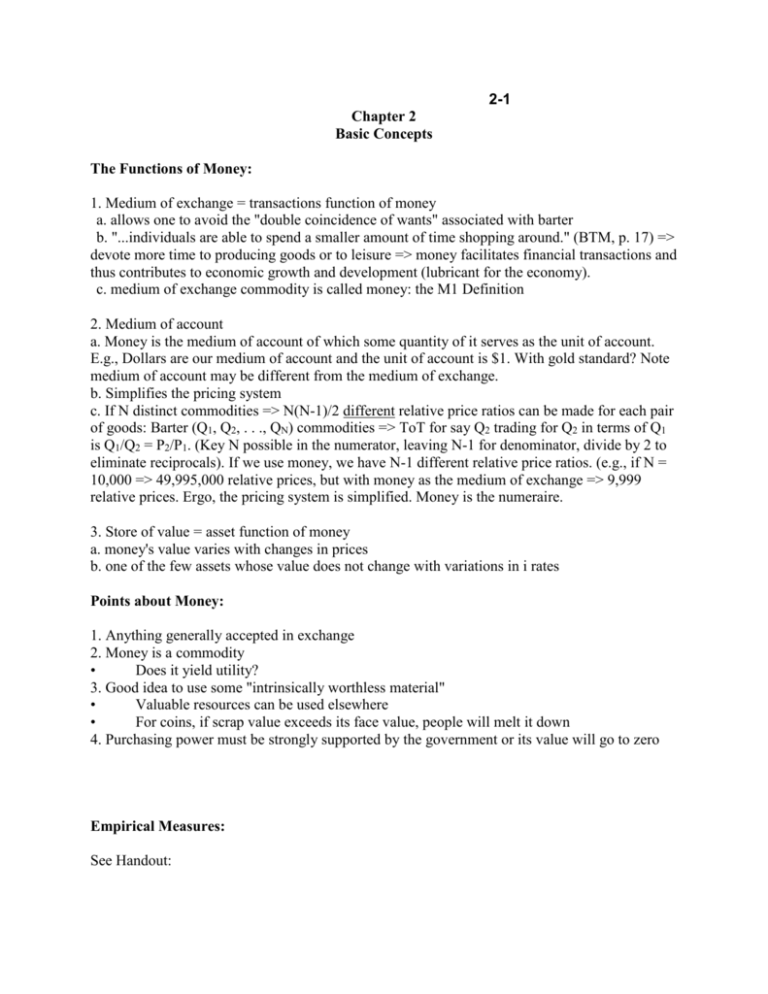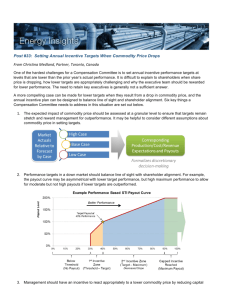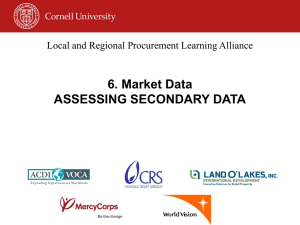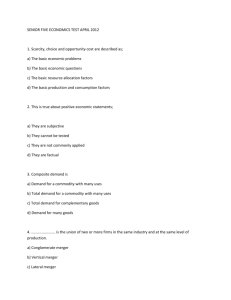Chapter 2 Notes - Andrew.cmu.edu
advertisement

2-1 Chapter 2 Basic Concepts The Functions of Money: 1. Medium of exchange = transactions function of money a. allows one to avoid the "double coincidence of wants" associated with barter b. "...individuals are able to spend a smaller amount of time shopping around." (BTM, p. 17) => devote more time to producing goods or to leisure => money facilitates financial transactions and thus contributes to economic growth and development (lubricant for the economy). c. medium of exchange commodity is called money: the M1 Definition 2. Medium of account a. Money is the medium of account of which some quantity of it serves as the unit of account. E.g., Dollars are our medium of account and the unit of account is $1. With gold standard? Note medium of account may be different from the medium of exchange. b. Simplifies the pricing system c. If N distinct commodities => N(N-1)/2 different relative price ratios can be made for each pair of goods: Barter (Q1, Q2, . . ., QN) commodities => ToT for say Q2 trading for Q2 in terms of Q1 is Q1/Q2 = P2/P1. (Key N possible in the numerator, leaving N-1 for denominator, divide by 2 to eliminate reciprocals). If we use money, we have N-1 different relative price ratios. (e.g., if N = 10,000 => 49,995,000 relative prices, but with money as the medium of exchange => 9,999 relative prices. Ergo, the pricing system is simplified. Money is the numeraire. 3. Store of value = asset function of money a. money's value varies with changes in prices b. one of the few assets whose value does not change with variations in i rates Points about Money: 1. Anything generally accepted in exchange 2. Money is a commodity • Does it yield utility? 3. Good idea to use some "intrinsically worthless material" • Valuable resources can be used elsewhere • For coins, if scrap value exceeds its face value, people will melt it down 4. Purchasing power must be strongly supported by the government or its value will go to zero Empirical Measures: See Handout: 2-2 Federal reserve System's Monetary Aggregates: Current Definitions of the Money Supply M1 M2 M3 TR H (high powered money = monetary base) a. Monetary Base represents net wealth for the private sector. Why? Currency + claims to currency is not offset by private liabilities. D is the depositors asset but it is offset by the bank's liability. Currency and reserves are the Fed's liability (U.S. Treasury's for coins) and the Fed is not a private institution. b. Base has a stable relationship with the size of the money supply. M = µ (R;k,cr)H where µ is the M1 reduced form money multiplier derived in Chapter 4, R = interest rate, k = RR/D, and cr = C/D. For 1999 the M1 multiplier = 1102/558 M2 multiplier = 4540/558 Theoretical Definitions of Money Keynesian: must satisfy the medium of exchange property => M1 Friedman: money must have two properties 1. temporary abode of purchasing power 2. cost of converting into a means of payment must be negligible Money Standards: Fiat Versus Commodity Money U.S. money is fiat => decreed to be money by law. In the 1790s in France the death penalty was imposed on those who would not take the domestic currency. a. circulating medium is paper or some low cost material b. does not represent a claim to something of value c. purchasing power of the paper money is kept greater than its production cost (i.e., seigniorage) *Need the supply of money to be controlled. Commodity money (purest form): a. medium of exchange "is a good that would be valuable even if it were not used as money." (BTM, p. 22) b. The government may or may not coin the commodity in question. (e.g., gold and silver) c. Value of money = inverse function of the price of some costly good. PgQg = P2Q2 , set Pg = 1. If P2 rises, you must give up more units of Au to obtain Q2. d. Given a full competitive equilibrium, the value (Pg) of the monetary commodity = MC of producing the commodity (Au) => "prices are determined by technological conditions relating to the production of the commodity." (BTM, p. 23) => tech for mining Au => Qg = P2Q2, 2-3 where Q2 is held constant. Commodity money (less pure form) a. Commodity itself does not circulate as the medium of exchange. Instead, token paper, representing a claim on the commodity, serves as the actual circulating medium. b. Value of one unit of the monetary commodity (or its claims) = MC of production of the commodity. c. e.g., the U.S. from 1776 to 1933. Commodity money (e.g., Gold standard) Money, Credit, and Financial Intermediation Credit: a. "any loan constitutes an extension of credit from a lender to a borrower" b. net credit = zero (credit extended = debt incurred (- credit)) c. domestic nonfinancial debt = "total quantity of debt in the form of ‘credit market instruments’ owed by households, nonfinancial businesses, and units of government." (BTM, p. 26) = outstanding credit mkt debt of Federal, State, and Local Governments, and private nonfinancial sectors. Includes: "U.S. Treasury securities, Federal agency securities (GNMA & Student Loan Market Association — Sallie Mae bonds), tax-exempt securities, corporate and foreign bonds, mortgages, consumer credit, open-market paper (commercial paper), banker's acceptances, bank loans, and other loans." Domestic Nonfinancial Debt in 1991: Households 4060.7 Nonfinancial Business 3509.5 State & Local Government 882.6 Federal Government 2776.3 and = Gross Fed Debt net of debt held by agencies trusts. Total 11229.1 Financial Sector Debt = 2648.2 Borrowers include: Sponsored credit agencies (Freddie Mac — FHLMC & FNMAE — FNMA), mortgage pools (GMAC), private financial sectors (commercial banks, bank affiliates, savings and loan associations, mutual savings banks, finance companies), Flow of Funds Accounts 1. Shows the movement of funds between financial and nonfinancial sectors. Volume of Financial Intermediation 1. refers to loan activities of private financial institutions 2. measured by the sum of credit market claims (i.e., loans outstanding to consumers, businesses, and government) held by intermediary firms 2-4 3. Table 2-4 (in billions of dollars) Claims Held By 1991 Commercial Banks 2860.5 Savings Institutions 1184.6 Insurance and Pension Funds 2433.5 Other Fin. Intermediaries 2001.8 Total 8480.4 Financial Intermediaries 1. channel funds from lenders to borrowers 2. "...assume liabilities of smaller default risk and greater predictability of value than their assets." BTM (p.27) quoting Tobin. How can they do this? a. administrative economy (economies of scale) b. expertise in negotiating, accounting, appraising, and collecting c. diversification => less risk with respect to loan default and deposit withdrawal d. FDIC insurance => smaller real interest rates => expansionary influence 3. Create liquidity Why discuss monetary economics with little attention to financial markets? 1. "In making borrowing and lending decisions, fundamentally rational households (and firms) are concerned with goods and services consumed or provided at various points in time. => Household are concerned about consumption and the labor they supply in the present and future. Choices involve budget constraints => they are equivalent to decisions about borrowing and lending — that is, supply and demand choices for financial assets." BTM, p. 29 e.g., to consume more than one’s income => one must borrow BTM focuses on the savings/consumption decision rather than on the borrowing/lending decision 2. BTM assumes households and firms are concerned with real (as opposed to nominal) variables. => focus on quantities of goods and services acquired or supplied, in the present or in the future, not the dollar magnitudes involved. Classical: concerned only with quantities and relative prices (e.g., PPF, theory of consumer demand,...) => "...rational households and firms are concerned with real magnitudes that they buy and sell of corporate bonds, Treasury bills, ..." => since they are formulated in real terms, there is no necessary connection between financial and monetary issues. E.g., suppose the Ms increases 10% => Prices increase 10% and stock market increases 10% there is no effect on real stock prices. Is money neutral? 1. BTM seems to imply that money is neutral—changes in money have no real effects. BTM says that there are some circumstances where money is not neutral. 2-5 Homework #1: 2,4 page 31.









